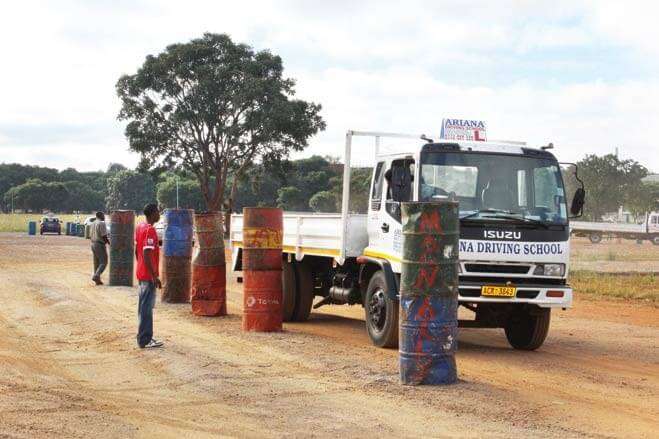Provisional Driving Licence Test Possible Questions & Answers pdf

We found these 80 Zimbabwean provisional driving test questions and answers on social media and we thought our readers would benefit from practising them.
They are from a provisional driving test questions pdf Zimbabwe 2022. Remember to verify them with a certified instructor from a registered driving school.
Question 1-10 Of The Provisional Driving Test Questions pdf Zimbabwe 2021
Question 1. What shape and colour is a warning sign?
Diamond Shape – Yellow and Black
Question 2. When should you not drive?
While under the influence of alcohol, drugs (prescribed or otherwise), or when tired or drowsy.
Question 3. What should always be kept clean on your vehicle?
Lights, Reflectors, Windows, Mirrors, Registration plate.
Question 4. What is the rule about passing animals on the road?
Slow down, give plenty of room, do not sound your horn or rev your engine. Have patience.
Question 5. Can you reverse from a minor road on to a major road?
No. (You should only reverse from a major road to a minor road).
Question 6. What shape is the sign that regulates?
Regulatory signs are round with red on white background with the exception of two: Stop and Yield.
Question 7. When should you use your hazard lights?
When your car is broken down, being towed, or at the scene of an accident.
Question 8. What vehicles are prohibited from using a motorway?
Learner driver vehicles, motorbikes under 50cc, invalid cars or horse-drawn vehicles, or any vehicles not capable of attaining 50kph.
Question 9. What should a broken white line mean to you?
A broken white line divides the centre of the road and should only be crossed if it safe or necessary to do so.
Question 10. What is the sequence of the traffic lights?
Green – Amber – Red – Green.
Question 11. What is the rule on entering a roundabout?
Give way to traffic on your immediate right.
Question 12. Name some places where you should not overtake.
Where you cannot see far enough ahead – a humpback bridge – too close to junctions – corners – pedestrian crossing – hatch markings – over a continuous white line.
Question 13. Name some places where you should not park?
Too close to a junction – opposite a stationary vehicle – corners – double yellow lines – single yellow lines (within time zones) – opposite a continuous white line.
Question 14. What is the hard shoulder used for?
Emergencies, breakdowns, Pedestrians and Cyclists.
Question 15. What is the overall stopping distance at:
-
- 50km/h
- 60km/h
- 80km/h
- 25 mtrs.
- 35 mtrs.
- 55 mtrs.
Question 16. What do the rules of the road say about sounding your horn?
You should not sound your horn between the hours of 11.30 pm and 7.00 am except in emergencies.
Question 17. To keep your vehicle in legal condition, what should you pay particular attention to?
Brakes – lights – tyres – steering – indicators – wipers – speedometer – horn – silencer.
Question 18. What are the minimum lighting requirements on your vehicle?
A motor vehicle (except a motorcycle) must be equipped with two headlights (white or yellow), two white side lights (front), two red rear lights, two red stop lights at rear, two red rear reflectors, number plate lighting to the rear and amber directional indicators front and rear.
Question 19. What does an amber traffic light mean?
Stop, if it is safe to do so.
Question 20. How should you approach a green light that has been green from the first time you have seen it?
Approach with caution at a speed which would enable you to stop safely if necessary, preferably in 3rd gear or lower.
Question 21. Name two ways of coasting?
Keeping clutch depressed while moving, or out of gear while car is coming to a stop.
Question 22. When parked on the left, what should you do before moving off?
Check your rear and right mirrors, signal and look over your right shoulder to check your blind spot and look forward again before moving off.
Question 23. Which is the safest way to park your vehicle at night?
Passenger side to the kerb, (reflectors to the following traffic).
Question 24. What should you do if blinded by oncoming lights at night?
Look to the left, slow down, move on and if you are still blinded slow down more or stop.
Question 25. What is the first thing you should do after being involved in an accident?
Stop your vehicle and check if any passengers are ok.
Question 26. What side of the road should your passengers alight from, especially children?
Pavement side.
Question 27. If a blind person were crossing the road, how would you know that he/she was blind?
There would be two reflective bands on his/her white stick or guide dog.
Question 28. When may you overtake on the left?
When the driver in front of you has signalled his intention to turn right and you have room to do so.
– In slow-moving traffic where the left-hand lane is moving quicker than the right-hand lane.
– When you are turning left.
– On a one-way street.
Question 29. What should you do before doing any type of manoeuvre?
Check mirror, give appropriate signals and check blind spots.
Question 30. What do Zig-Zag lines mean on approach to a Zebra crossing?
No overtaking, no parking, no stopping (except for traffic reasons).
Question 31. Give some examples where you should be “more” aware of pedestrians?
Corners – traffic lights – junctions – bus stops – when overtaking parked cars or trucks – around ice-cream vans – near schools.
Question 32. If you were driving along the road and felt drowsy, what should you do?
Pullover, stop and open your window. (DO NOT DRIVE WHEN DROWSY)
Question 33. At a pelican crossing what does a flashing amber light mean?
Proceed with caution if no pedestrian is crossing.
Question 34. When should you use your lights during daylight hours?
During poor visibility, falling snow, fog or rain.
Question 35. What is the minimum legal tread depth on a tyre?
1.6mm
Question 36. How many types of pedestrian crossing are there?
Two, controlled (pedestrian traffic lights) and uncontrolled (flashing amber beacons).
Question 37. How would you describe an uncontrolled pedestrian crossing?
Flashing beacons and black & white road markings with zig-zag lines.
Question 38. What is a controlled pedestrian crossing?
Pedestrian traffic lights.
Question 39. What signs would you expect to see approaching a major road?
Warning sign – major road ahead – regulatory sign: yield or stop.
Question 40. What markings are you likely to find at traffic lights?
Stop line – two pedestrian lines – two yellow lines – continuous white line – yellow box – directional arrows.
Question 41. What road markings would you expect to see prohibiting you from entering a one-way street?
A continuous white line painted across the entrance of the road, backed by a broken white line, also a NO ENTRY sign.
Question 42. What are chevrons?
They are directional arrows to indicate deviation ahead, bad bends etc. You must follow the arrows.
Question 43. Why is a stop sign or a yield sign so shaped?
If defaced or covered in any way, the driver recognises the shape.
Question 44. On your driving test, must the manoeuvre be completed in three movements while doing your turnabout?
No, it can be done in 3, 5 or 7 movements. The less the better. Most cars can do it in three depending on the size of the road and car.
Question 45. How many types of road signs are there?
Three: Informative (information signs), warning (black diamond shape) and regulatory (round).
Question 46. Where would parking obscure the view of others?
At junctions, on a bend or brow of a hill, on the approach side of a zebra crossing.
Question 47. What is the minimum insurance on a vehicle?
Third-party.
Question 48. Name some conditions that you would need to increase your braking distance?
Rain (road wet after a dry spell), ice, snow, fallen leaves, loose chippings, worn tyres.
Question 49. What is the significance if the driver flashes his/her lights at you?
Take note of his/her presence.
Question 50. What is the national speed limit?
Ans. 80kph (120kph on a motorway)
Question 51-60 Of The Provisional Driving Test Questions pdf Zimbabwe 2022
Question 51. What vehicles must you give way to at a junction of equal importance?
All vehicles approaching from your right and traffic already at the junction.
Question 52. Name some signs and road markings that would prohibit you from parking?
No parking signs, clearway signs, bus lane signs, yellow lines or continuous double white lines in the centre of the road.
Question 53. When is particularly dangerous to park on the road at night?
In heavy fog or in badly lit areas.
Question 54. What lights should you have on in fog?
Dipped headlights & fog lights on rear if fitted.
Question 55. What must you make sure of before starting a reverse?
That you have a clear view and that no pedestrians, especially children, are crossing behind you.
Look out for cyclists.
Question 56. How do you approach and take the third exit off an ordinary four road roundabout?
You must check your rear and right mirrors signal right and manoeuvre right (just left of centre) on approach. Maintain your signal until you reach the exit before the one you want to take, then you must check your rear & left mirror and change your signal to the left, manoeuvre left and exit.
Question 57. How should you take the 2nd exit off a roundabout?
You must check your mirrors, drive-in on the left-hand side, no signal until you pass the first exit, check your mirrors, then signal left and exit.
Question 58. What must you remember before you overtake?
You must have a clear view ahead and then use the “mirror, signal, mirror” manoeuvre technique.
Question 59. What do you do on approaching a junction to turn left/right if there are pedestrians already crossing?
Slow down allow them to cross, stop if necessary.
Question 60. What is a bus lane?
It is for the exclusive use of buses, taxis and cyclists within the specified times.
Question 61. At a road junction, where must you stop?
You must stop at or before the stop line.
Question 62. What should you not do when you are being overtaken?
Accelerate or move to the right.
Question 63. What position should you adopt when turning right?
Just left of the centre line of the road, except in cases of emergency.
Question 64. What is the meaning of a single white line in the centre of the road?
It divides the road and should not be crossed except in exceptional circumstances e.g. an accident, road works, parked cars, cyclists or other obstructions.
Question 65. Should you beckon pedestrians across a crossing?
You should not beckon pedestrians or other road users, as other vehicles may be approaching, they must make the decision for themselves.
Question 66. What sign prohibits you from entering a one-way street?
A round sign, white within a red circle, and arrow with a slash through it.
Question 67. What is recommended when carrying a child?
Child restraints and car seats.
Question 68. What is the difference between a single yellow line and a double yellow line?
Single yellow line – parking at certain times is allowed, read the signposts.
Double yellow line – No parking at any time.
Question 69. What are the rules for giving hand signals?
Clearly and in good time, and for long enough to be understood.
Question 70. If you are asked by a police officer to produce your driving licence and you don’t have it with you, what is your position by law?
You are required to carry your licence while driving but you have 10 days to produce your licence at a Police Station of your choice.
Question 71-80 Of The Provisional Driving Test Questions pdf Zimbabwe 2021
Question 71. Describe motorway countdown markers.
Rectangle blue signs. 3 bars – 300 meters, 2 bars – 200 meters, 1 bar – 100 meters.
Question 72. How long is the driving test for class “B” (car)?
25 – 45 mins.
Question 73. What should you not do after overtaking?
Cut in, slow down or stop.
Question 74. Name some thing’s you should never do on a motorway?
Enter a motorway as a learner driver, exceed the speed limit, reverse, stop, walk on a motorway or cross the reservation.
Question 75. When should you dip your headlights?
When meeting oncoming traffic, in built-up areas, in fog or falling snow, when following close behind another vehicle, at the beginning and end of lighting-up hours, in heavy rain and on dull days.
Question 76. Immediately after parking, what instrument should be operated first?
Your hand brake.
Question 77. When driving on country roads, what should you pay particular attention to?
Wandering animals, farm machinery, concealed entrances and persons herding animals.
Question 78. What legal requirements must you have before going to drive a vehicle?
Valid licence, valid tax and insurance and a roadworthy vehicle.
Question 79. When may you drive on the right-hand side?
In a one way street.
Question 80. What is meant by the word “Aquaplaning”?
When bald or worn-out tyres can’t cope with the build-up of water underneath them. This leads to loss of control of your vehicle.
Question 81. What type of road should you never reverse into?
A major road or a one-way street.
Question 82. Where would you see a triangle painted on the road?
On approach to junctions, roundabouts and yield signs.
If you practice these provisional driving test questions and answers you will have higher chances of passing VID provisional licence test. Good luck!
If you found value in this please share with your friends so they can benefit too.







































